Classification of cost
Fixed Costs
Fixed cost is a constant cost. It is cost that does not change with changes in volumes of output or production capacity. It is cost that must be paid whether the business is carrying out its ordinary activities or not.
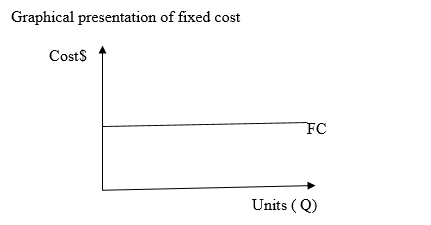
What do we mean when we say fixed cost does not change?
The answer to that question is that, as production increases, that cost remain the same. That is;

Let us interrogate this graph below;
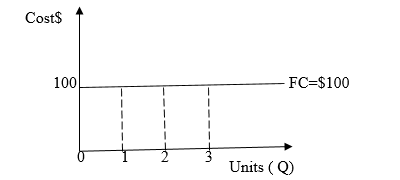
At zero (0) level of production, the fixed cost is at $100
At one unit (1) level of production, the fixed cost is also at $100
This means that the change in cost due to a unit change in quantity produced of a product,

This means no change, i.e. zero change which is said to be constant.
So when we say fixed cost is constant or fixed, we refer to no change. Like in the example above, the business continues to pay $100 all through even when production has either increased or reduced.
Even when the production level reaches three units the change in cost is zero (constant). That is, remain at $100.

Examples of fixed cost in a business are;
- Insurance
- Rent
- Monthly salary
That is, whether the business is producing or not, the motor vehicles and other properties has to be insured per annum, same with rent and employee salaries.
Variable Costs
As the name suggests, variable cost is a cost element which change with changes in the level of production. Such that, when production is at zero level, variable cost will be zero also. If production increases, the variable cost increases although it may not be at the same proportions.
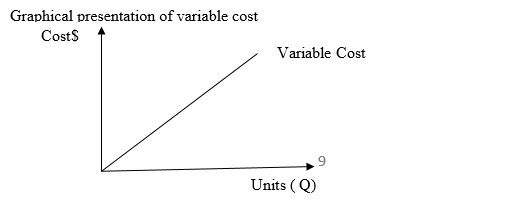
What do we mean when we say variable cost change with changes in the level of production?
The answer to that question is that, as production increases, also cost change. That is;
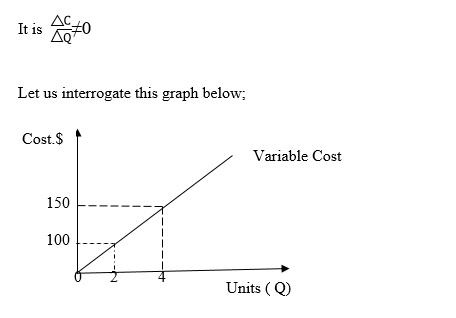
At zero (0) level of production, the variable cost is at $0
At two unit (2) level of production, the variable cost is at $100
This means that the change in cost due to change in quantity produced of a product is;

This means variable cost changes by $100, when production increases from zero (0) to two (2) units. So when we say variable cost varies, we refer to a change which is more than zero.
Even when the production level reaches four units the change in cost increases further. That is, increases from 100 to 150. Therefore the change in cost will be;

Examples of variable cost in a business are;
- Material cost
- Labor cost
- Packaging costs
That is, when the business produce more and more, the variable cost will change accordingly
Semi Variable Costs
Semi variable cost is mixed cost. That is cost which comprise both fixed and variable cost elements. It is also referred to as semi fixed cost. It is hybrid or cocktail kind of cost element. This kind of cost exist where at a certain level of production, the cost remains fixed and beyond such a level, cost change with changes in the level of production.
Example of semi-variable cost is total cost
Total cost is a combination of fixed cost and variable cost. That is, at a certain level band of production, the business pays for both fixed and variable cost. So
Total cost= fixed cost + variable cost
Graphical presentation of semi variable cost-case “a”
Semi variable cost can be presented in twofold
Case “a” Between zero units and nth unit
So you see, at zero level of production, the fixed cost remain constant. But when production starts, variable cost start to increase from zero value to a higher value as demonstrated below;
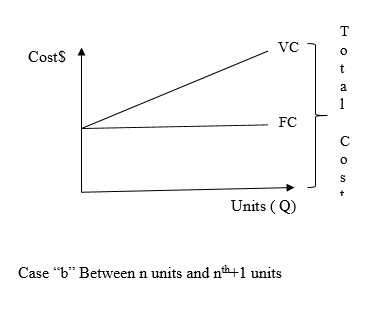
In case “b” cost element may remain constant at a particular production scale. But when the scale is increased or decreased, the cost increases or decreases in that manner although it might not be at the same proportions which remain constant again at that higher or lower level of production
Graphical presentation of semi variable cost-case “b”
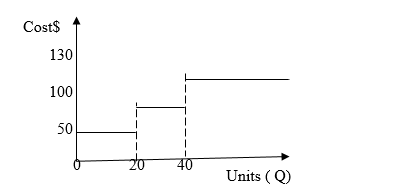
At zero production level up to 20 units, the fixed cost is at $50
Between 20 and 40 production level, the fixed cost is at $100
At production level beyond 40, the fixed cost is at $130